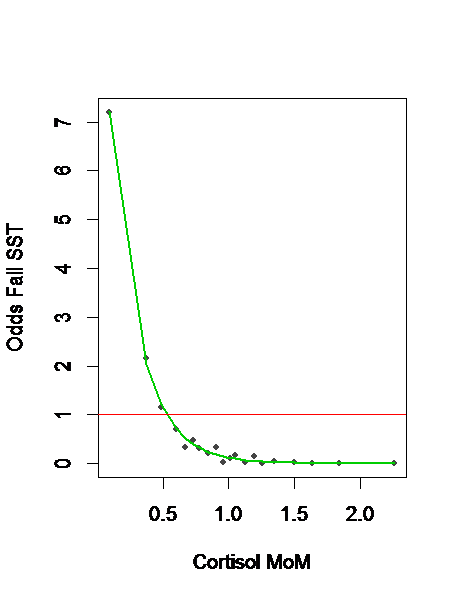Oral Presentation Annual Meetings of the Endocrine Society of Australia and Society for Reproductive Biology and Australia and New Zealand Bone and Mineral Society 2016
Use of time specific reference intervals for random morning cortisol assists prediction of Synacthen stimulation test outcome (#124)
Background:
Cortisol has a circadian rhythm and time of day may affect random levels. Synacthen stimulation tests (SST) may be used to clarify low random cortisol levels.Aim:To determine the utility of time specific reference intervals (Multiple of medians,MoMs) in predicting SST outcome.
Methods:
Random cortisol results (n=14000) from one laboratory over 13 years were extracted and appropriate exclusion criteria applied. All SST’s (n=833) were also extracted and after exclusions, 174 (21%) failed the SST. To establish medians for each discrete 30 minute time interval (7 am to 12 midday) the random cortisol data set was used. The median value for a time interval was given the value of 1.0 and all random cortisol results were then assigned a value corresponding to a multiple of timed median. For example a cortisol half the value of the median value for a given time would have a value of 0.5 MoM. The odds of failing the SST based on a single cortisol value were calculated using either the cortisol MoM or raw basal cortisol. We also compared timed odds of SST failure at different times of collection.
Results:
The odds of SST failure increased as cortisol MoM decreased, with highest odds (7.2) at a cortisol MoM of 0.27. Low odds (0.05) of failing the SST occurred with Cortisol MoM > 1.23. At a cortisol MoM of 0.53, there were even chances of passing or failing an SST. The overall odds of SST failure calculated in 30 minute intervals over the morning were relatively consistent.
Conclusion: Time of SST does not predict outcome. However use of a time specific reference interval for random morning cortisol comparing results to a time specific median, does improve prediction of SST outcome
